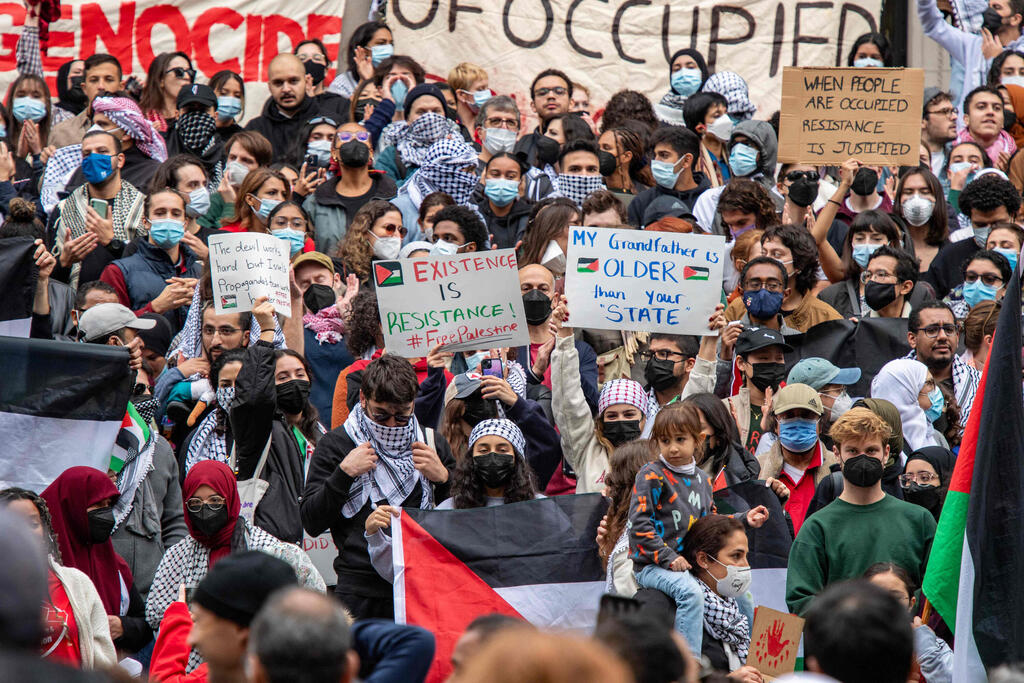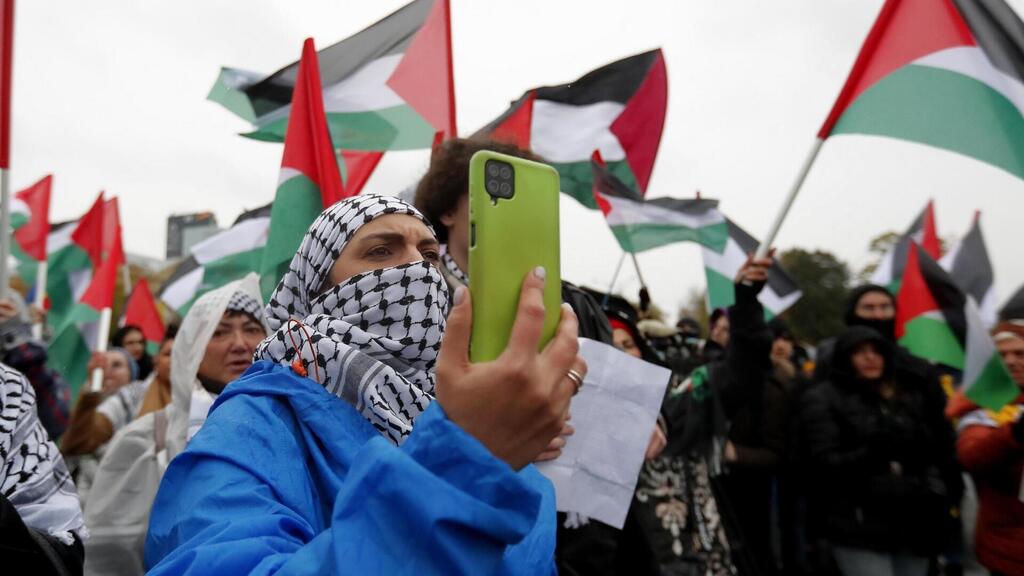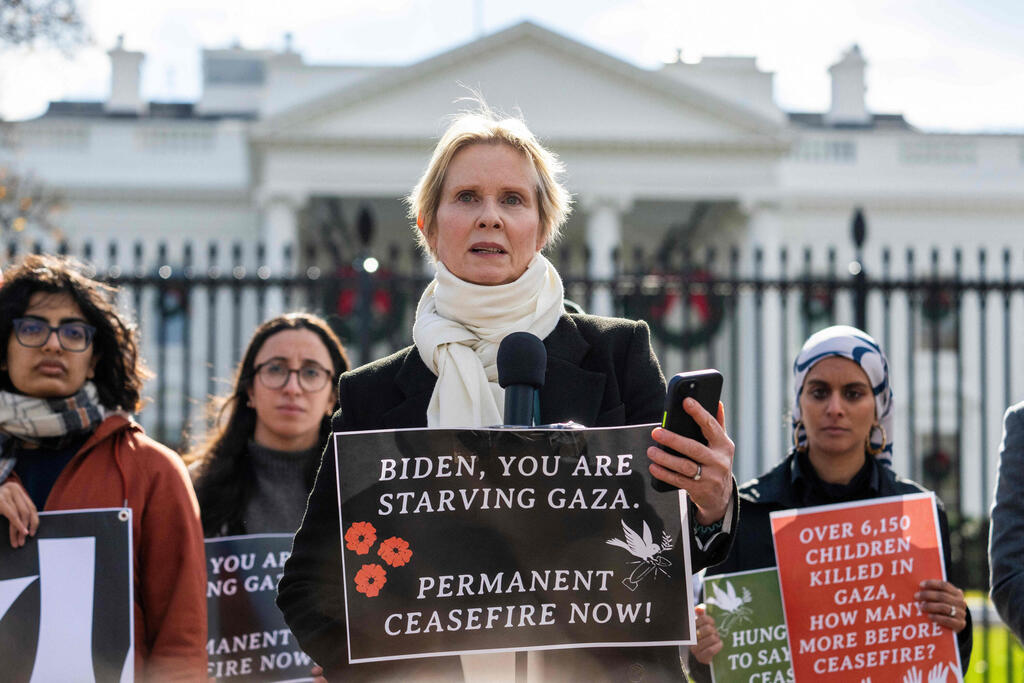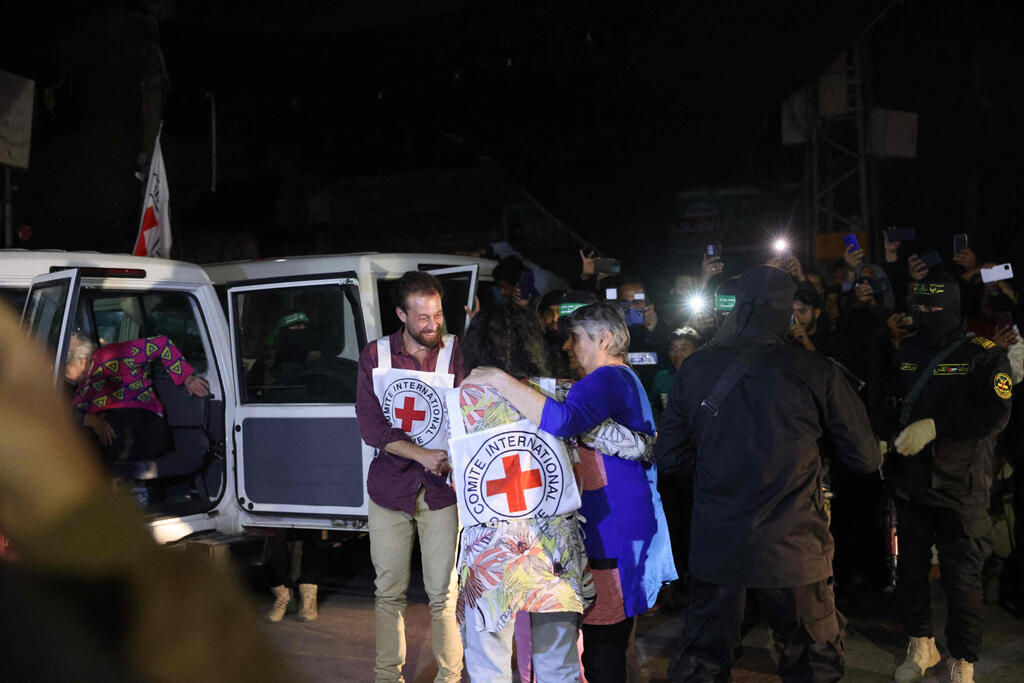Flags, demonstrations, watermelons, a protest in front of a falafel restaurant – people throughout the Western world are taking to the streets (or just typing vigorously) to protest against Israel and stand for the liberation of the Palestinians. "Free Palestine", they keep chanting, "stop the fire". And what about the terrorist organization Hamas? They don’t mention Hamas.
This phenomenon, which is happening now right before our eyes, has roots and history, but it is also related to a well-planned and sophisticated distribution of a brand.
So how did the Palestinians become an issue that brings to the streets crowds that are very distant from the Middle East? According to Prof. Eytan Gilboa, this is a process that started 20 years ago. "At the 2001 UN Conference against Racism in Durban, South Africa, Palestinian organizations and radical left organizations, along with human rights organizations, took over the conference. It turned into an anti-Israel conference. When the Palestinians saw that it worked, they adopted it as a strategy for the liberal Western world," says Gilboa, an expert on the United States at Bar Ilan University and a senior research fellow at the Jerusalem Institute for Strategy and Security.
This is not a coincidence of timing or location. "No wonder it started in South Africa. They realized that it was possible to attack Israel's policies on human rights, and they promoted the notion that Israel is an apartheid state," he clarifies. "Human rights organizations worldwide, such as Human Rights Watch and Amnesty, helped the Palestinians. They invented definitions of apartheid and tried to apply them to Israel, saying that apartheid also takes place inside Israel and not only in the Palestinian territories. Even back then they said that there was a holocaust in Gaza."
And similar to that starting point in South Africa, today's pro-Palestinian demonstrations also take place in certain carefully selected areas. "Since the massacre, they have been targeting audiences throughout the United States, Canada, Australia and Western Europe. They are taking advantage of the sensitivity of Western countries to human rights in order to gain sympathy for their positions. These are democratic, liberal countries that sanctify human rights. So it turns out that people who should be on your side support Hamas and the Palestinian Authority, which are reactionary factors."
The factors behind the scenes, Gilboa explains, are the "green-red-white alliance", meaning a combination of the radical left, Muslim organizations, and right-wing anti-Semitic whites. Together they spread the rhetoric of the "dehumanization of Israel," according to Gilboa.
They promote this dehumanization narrative on the basis of their activity, i.e. colleges and universities throughout the United States, and as we have already witnessed, since October 7 the campuses have become the focus of anti-Israeli activity, and the universities do not protect Jews from being attacked - a phenomenon that reached its peak recently with the shocking statements of Harvard, MIT and UPenn presidents during a congressional hearing.
And how did the alliance against Israel become so well established on the campuses? This is where the well-known BDS organization enters the picture. This boycott movement used the money coming from Qatar to "take over" entire departments in universities across Europe and the United States. There they promote the notion that Israel is a country of white people oppressing blacks - similar to the oppression that took place in the USA.
"The Jewish community in the United States treated it with tolerance, and now it blows up in their faces," says Gilboa. "All these streams have intensified significantly in the last 20 years. They were overlooked and no one considered them a threat."
I am on the right side
The great interest that the Palestinians are currently arousing in the US is related to two issues that agitate American society and will continue to be a bone of contention: racism and colonialism. In the "Today, Explained" podcast, the Vox Media anchors explained how "Palestine went global".
6 View gallery
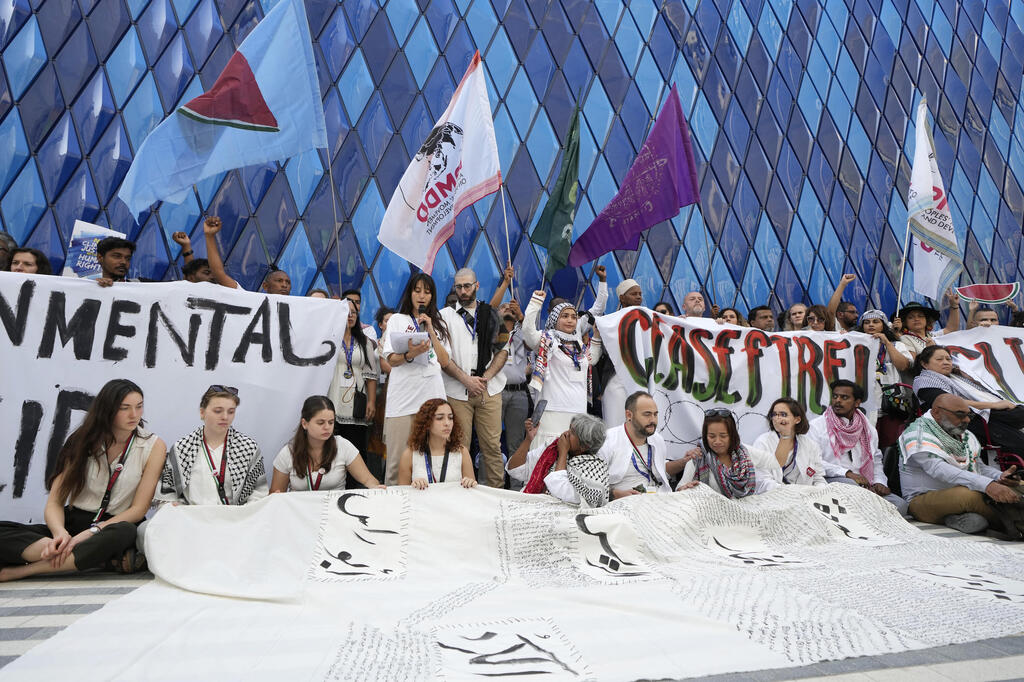

Pro-Palestinian demonstration at the COP28 climate summit in Dubai
(Photo: AP Photo/Peter Dejong)
The anchors covered a pro-Palestinian poetry reading event in the Little Village immigrant neighborhood in Chicago. The participants who were interviewed explained that for them Israel is imperialist, first and foremost because in their opinion the local population is the Palestinians and not the Jews.
One interviewee said that he met Palestinian activists during demonstrations of the Black Lives Matter movement, who protested against discrimination of blacks and police violence. He and his friends considered it a shared fate, having the same goals, even though there is not much similarity between slavery and racism in the U.S. and the Israeli-Palestinian conflict.
The colonialist narrative also derives from the BDS movement, explains Prof. Elie Podeh of the Department of Islamic and Middle East Studies at the Hebrew University of Jerusalem. "It's a narrative that involves Zionist colonialism, which goes back to the position that Israel was established by Western imperialists."
These are not just slogans that one can easily shout into a megaphone, but rather an internal movement that is related to justice and morality concepts. "The demonstrators around the world, from various left-wing parties, perceive this as a clear expression of injustice," explains Podeh. "They believe that many injustices have been done, and they add up to a harsh consistent Israeli policy throughout the years."
However, in recent years the Palestinian issue did not stand out at all in the international discourse. This may be another reason to have an interest in it now. During recent developments in the Israel - Arab countries relations, which involved the normalization agreements, it was evident that the Palestinians were left out and their interests were not taken into account. "In recent years, the world has forgotten the Palestinians," says Podeh. "In addition, the policy of the Netanyahu government tried to disregard the Palestinians, and that was a mistake.
"The normalization agreements stated clearly: the Palestinians are less important. The Arab countries agreed with that. This feeling of injustice has accompanied the left-wing parties for many years, but now it has become more extreme."
Actress Cynthia Nixon, best known for her role as Miranda from "Sex and the City", recently announced a hunger strike over the war in Gaza. In an interview on the American talk show "The View", she was also asked what led her to demand a ceasefire and demonstrate in front of the White House.
"I am the mother of two Jewish children, whose grandparents are Holocaust survivors. My oldest son asked us to affirm that 'never again' means 'never again' for everyone," she stated to audience applause. When asked as a women's rights activist about the international women's group who stayed silent on the sex crimes committed against Israelis on October 7, she went on to quickly condemn Hamas - but immediately returned to the issue of the children killed in Gaza.
For many Israelis, Nixon's conduct is an excellent example of the West's approach to what is happening here, in Israel. People who have never been personally involved in the conflict, whose lives take place in safe and protected worlds without experiencing alarms or kidnappings, express an unequivocal opinion, ignoring the fact that this conflict has two sides.
"When such figures say such a statement, they in fact talk about themselves, not the conflict," explains Asa Shapira from Tel Aviv University's Communications Department. "They actually say, 'Look at me, I'm on the right side of the conflict.' This is a problem that is prevalent in Western countries, because it reduces the readiness for real political action. Changing a profile picture to a country's flag is an act that reduces the readiness to take real action in favor of that same group, because it makes us believe that we've done what we were 'supposed' to do. Meaning, we engage in what we project to the world about ourselves."
Americans who wish to cleanse themselves of the racism crime that haunts their society, explains Shapira, would adopt the narrative of blacks and whites, as if to mend their ways. When they oppose Israel, they consider themselves as if they oppose racism. "The 'Woke' movement expresses a general mindset. Public figures want to leverage it, either to get Likes and love from the public or because they connect to the notion that the oppressed are the Palestinians and the Israelis are the vile oppressors.
"From their point of view, when they engage in virtue signaling and speak out against Israel and against Zionism, they are expressing their moral viewpoint to the world."
The word 'Palestine' appears but not 'Hamas'
Those who often lead the demonstrations and the opposition to Israel online are the young people, the members of Generation Z. Nataly Izchukov, owner of the trend forecasting agency The Visionary, provides a somewhat surprising explanation: these young people are lonely. According to her, many of them feel lonely and need something that will connect them with their peers. Social struggle is such a connecting factor.
6 View gallery
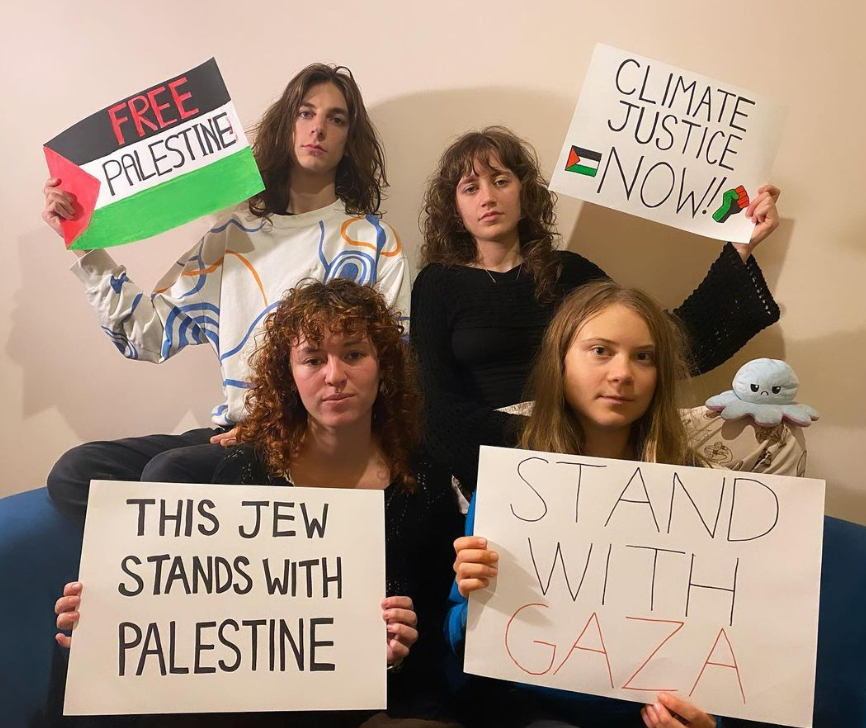

Climate Activist Greta Thunberg and her friends show their support for the Palestinians
(Photo: from Instagram)
"This issue relieves loneliness," Izchukov explains. "It's a lonely generation that wants to feel like it's doing something, and that's how they suddenly find themselves a community, meetings, demonstrations. Suddenly they have something to vent their anger on, they have a moral goal to support, and expressing support for Israel is not cool."
This is a generational matter, Izchukov explains. "Greta Thunberg, for example, is part of a generation that fights against conventions. She came to the conclusion that we are the bad guys, and no one is there to stop it and say 'enough, both sides are getting hurt'. There is no attempt to build peace and unity, but rather division. She deepens the gap."
Izchukov adds that Hamas adapts itself to the younger generation, which worships constant self-documentation. "The 'presentation culture' is showing everything on social networks. They display everything all the time, when they are sad or happy. They constantly engage in what to show and when."
Hamas responds to the younger generation and provides them with a show - they create an image for the sake of social networks. An image that would 'sell' their message. "When the Israeli hostages were released, one can notice that Hamas has photographers, directors, producers. Everything is very planned," Izchukov explains. "There is a well-oiled public relations and advertising system. Hamas is producing a film, directed and filmed by a terrorist organization, which made the multitudes of boys and girls believe that we (Israel) are the ones to blame, and we should pay the price. They want to create tension, catharsis. They know exactly who they want to release and when, for example, to separate mother and daughter."
According to Izchukov, the colors also play a role in attracting the West to the Palestinians: "Visually, the Palestinian flag is beautiful. The combination of colors, red and green, is connected to the colors of Christmas. Israelis accused many companies, such as Zara, of using these colors in their ads; Zara responded that it did not refer at all to the war, but to Christmas."
The combination of green and red, says Izchukov, is more accessible and sexier than Israel's blue and white. "What Israeli image can be imitated? There was indeed a time when Madonna wore a 'Chai' necklace. Today, the hijab has become very popular among Generation Z's young women. Similarly, the trend of wearing a Keffiyeh (a traditional Arab headdress) in 2015 was very popular in Europe. When young people were asked what the meaning of the keffiyeh was, they had no idea. This means, they don't know what it's about, they just listen to Bella and Gigi Hadid, and to The Weekend."
Speaking about colors reminds Izchukov of a magazine that excited her, until she found out who was behind it. "ISIS produced a stunningly beautiful magazine, it's hard to admit, in terms of visuals. It proved to me how easy it is to manipulate people. The people in charge of these terrorist organizations employ creative professionals. The orange color of ISIS also emerged from a high level of thinking. In the past, a terrorist organization was simple and minimal. Today they are sophisticated. The most frightening thing is that the world does not get it."
The popularity of the colors is also portrayed in the symbol adopted by the Hamas movement, the watermelon, which started in 1967, after the Six Day War - when the Israeli government banned the display of the Palestinian flag. In 1993, the ban was lifted as part of the Oslo Accords, but the image of the watermelon was fixed.
The watermelon is a cute and relaxing symbol, it really makes you happy. It reminds of summer and joy, a family trip to the beach, but in some cases, it is used to hide terrorist messages from Hamas. And in general, the word Hamas itself is hidden. "No one talks about Hamas' damage to Israel, only about Israel's damage to Gaza," explains Izchukov. "In other words, Hamas is not mentioned. You see the word 'Palestine' but not 'Hamas'. They managed to blur the word Hamas."
Despite the fondness for watermelons and well-staged messages, Shapira believes that the younger generation's attention will eventually fade. "This is a generation so self-centered that even when it engages in conflicts, it is only to help them say something about themselves vis-à-vis their community. In that sense, we're having a problem because the West is weak. Israel is not very different; we also have forces that deal more with image than with action."
Why don't people check the story in depth?
"Ignorance has a lot to do with it. People are cognitively stingy; they have no interest in conducting an in-depth investigation. They want to say, 'Look at me, I am a moral person who works in the spirit of the times' and ride the wave. For them, this is another tool that allows them to engage in self-branding. When there is a trend, you want to reflect to your social world that you are a part of it. It doesn't matter if it's fashion or political discourse.
"This trend will pass. As they no longer deal with Ukraine, the average American student will move on. History teaches us that the next trend will follow, it might be a political or some other kind of ecological struggle."



